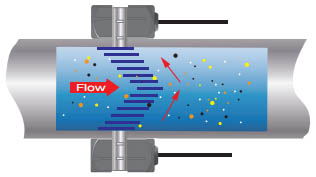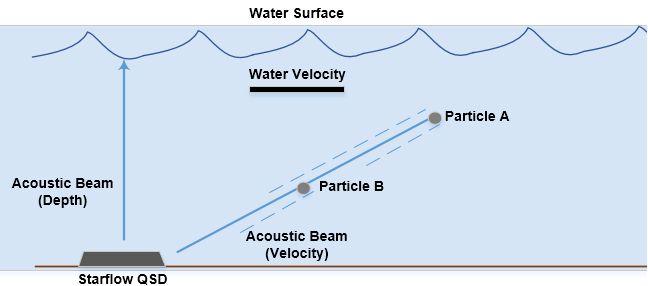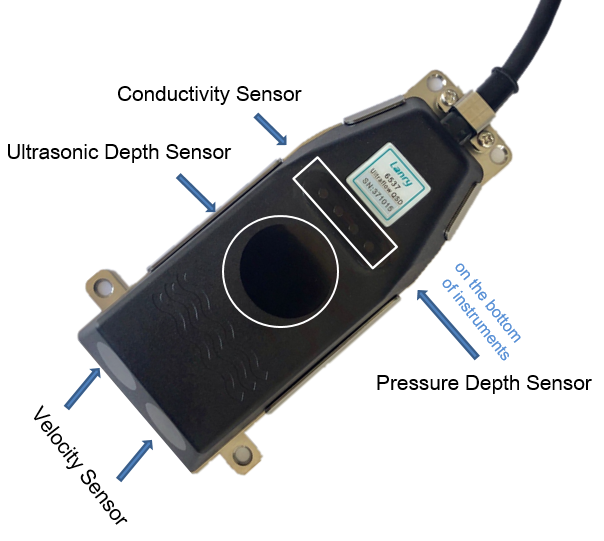Transit-time working principle
Principle of Measurement:
The Transit-time Correlation Principle makes use of the fact that the time-of-flight of an ultrasonic signal is affected by the flow velocity of the carrier medium. Like a swimmer working his way across a flowing river, an ultrasonic signal travels slower upstream than downstream.
Our TF1100 ultrasonic flow meters work according to this transit-time principle:
Vf = Kdt/TL
Where:
VcFlow velocity
K: Constant
dt: Difference in time of flight
TL: Ave rage Transit Time
When the flow meter works, the two transducers transmits and receives ultrasonic signals amplified by multi beam which travels firstly downstream and then upstream. Because ultra sound travels faster downstream than upstream, there will be a difference of time of flight (dt). When the flow is still, the time difference (dt) is zero. Therefore, as long as we know the time of flight both downstream and upstream, we can work out the time difference, and then the flow velocity (Vf) via the following formula.

V method
W method
Z method
Doppler operating principle
The DF6100 series flowmeter operates by transmitting an ultrasonic sound from its transmitting transducer, the sound will be reflected by useful sonic reflectors suspended within the liquid and recorded by the receiving transducer. If the sonic reflectors are moving within the sound transmission path, sound waves will be reflected at a frequency shifted (Doppler frequency) from the transmitted frequency. The shift in frequency will be directly related to the speed of the moving particle or bubble. This shift in frequency is interpreted by the instrument and converted to various user defined measuring units.
There must be some particles large enough to cause longitudinal reflection - particles larger than 100 micron.
When install the transducers, the installation location must have enough straight pipe length upstream and downstream. Commonly, the upstream needs 10D and downstream needs 5D straight pipe length, where D is pipe diameter.

Area velocity working principle

DOF6000 series open channel flow meter uses Continuous Mode Doppler to detect water velocity, an ultrasonic signal is transmitted into the water flow and echoes (reflections) returned from particles suspended in the water flow are received and analysed to extract the Doppler shift (velocity). The transmission is continuous and simultaneous with the returned signal reception.
During a measurement cycle Ultraflow QSD 6537 emits a continuous signal and measures signals returning from scatterers anywhere and everywhere along the beam. These are resolved to a mean velocity that can be related to a channel flow velocity at suitable sites.
The receiver in the instrument detects reflected signals and those signals are analysed using digital signal processing techniques.
Water Depth Measurement – Ultrasonic
For Depth measurement Ultraflow QSD 6537 uses Time-of-Flight (ToF) Ranging. This involves transmitting a burst of ultrasonic signal upwards to the surface of the water and measuring the time taken for the echo from the surface to be received by the instrument. The distance (water depth) is proportional to the transit time and the speed of sound in water (corrected for temperature and density).
The maximum ultrasonic depth measuremnt is limited to 5m.
Water Depth Measurement – Pressure
Sites where the water contains large amounts of debris or air bubbles may be unsuited for ultrasonic depth measurement. These sites are better suited to using pressure to determine the water depth.
Pressure based depth measurement may also be applicable to sites where the instrument cannot be located on the floor of the flow channel or it cannot be mounted horizontally.
Ultraflow QSD 6537 is fitted with a 2 bars absolute pressure sensor. The sensor is located on the bottom face of the instrument and utilises a temperature compensated digital pressure sensing element.

Where depth pressure sensors are used the atmospheric pressure variation will cause errors in the indicated depth. This is corrected by subtracting the atmospheric pressure from the measured depth pressure. A barometric pressure sensor is required to do this. A pressure compensation module has been built into the Calculator DOF6000 which will then automatically compensate for the atmospheric pressure variations ensuring an accurate depth measurement is achieved. This enables Ultraflow QSD 6537 to report actual water depth (pressure) instead of barometric pressure plus water head.
Temperature
A solid state temperature sensor is used to measure the water temperature. The speed of sound in water and its conductivity is affected by temperature. The instrument uses the measured temperature to automatically compensate for this variation.
Electrical Conductivity (EC)
Ultraflow QSD 6537 is equipped with the capacity to measure the conductivity of the water. A linear four electrode configuration is used to make the measurement. A small current is passed through the water and the voltage developed by this current is measured. The instrument uses these values to calculate the raw uncorrected conductivity.

